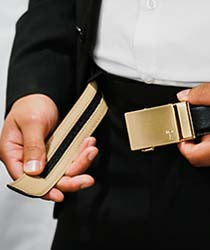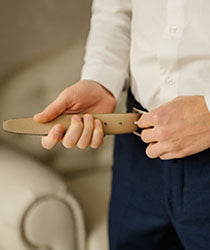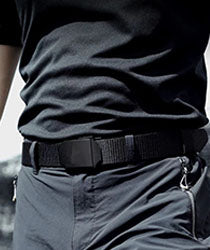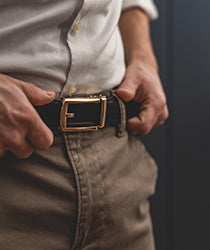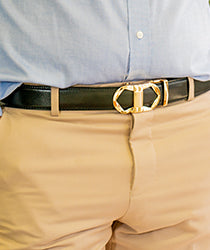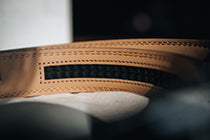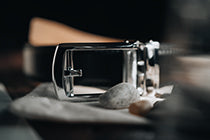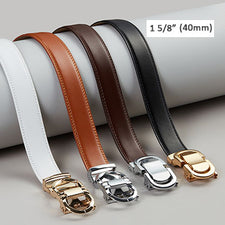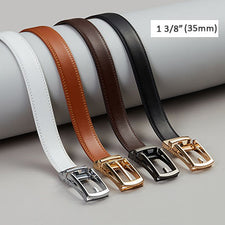You're in the market for a new leather belt but unsure if you should spend the extra money for the real thing or go with a faux leather belt that's a fraction of the price. Even if you decide to spend more, how would you distinguish between faux leather vs real leather?
Fortunately, there are some ways you can figure out whether a piece of leather is the real deal or not.
Many people are duped into thinking they're buying quality leather when they're getting something made from synthetic materials.
Let's dig further to discover traits of the real ones while testing faux leather vs real leather on multiple parameters.
Faux Leather vs Real Leather
Clothing made 100 percent of real leather is normally far more expensive than the clothing of vegan-based leather.
Real leather is made from the skin of an animal and is typically more expensive than faux leather.
Real leather has a more natural feel and smell. These two materials are very different in terms of quality and durability, but the price is undoubtedly one of the key differentiators between faux leather vs real leather.
10 Tests for Faux Leather vs Real Leather
You might wonder how to test if that sofa or handbag, wallet or belt, shoes or purse you're eyeing is real leather. Well, wonder no more! We put together 10 tests you can do instantly to figure out faux leather vs real leather differences.
Let's get started!
The Price Test
If the jacket is dirt cheap, it's probably not made of real leather. Leather is a luxurious material, so if the price is too reasonable to be true, it probably is fake leather.
But do try out some of the other tests listed in this article. With a little bit of know-how, one can tell which the real leather is in no time.
The Surface Grain Test
Take a good look at the surface of the leather. Do you see any little pebbles or pores? If so, that's a good indication that the leather is real. Faux leather won't have these pores because it's mainly made of polyurethane.
The Press Test
The press test is a simple way to determine the difference between original leather vs faux leather. Take the leather in your hands and press down on it with your thumb. Real leather will have tiny wrinkles and creases, while faux leather will be smooth.
The Smell Test
The smell test is the best way to determine the details of real leather vs fake leather. And it's one of the easiest tests to do.
Just take a whiff of the leather and see if it smells like, well, leather. If it doesn't, then it's probably not the real deal. Faux leather usually has a pretty distinct chemical smell.
The Fire Test
So you've got a leather jacket/bag/pair of shoes that you're not sure is real or faux. What do you do? One way to tell is to do the fire test.
Take a lighter and hold it close to the leather, watching for any reaction. If it's real leather, it might start to smoke or burn. Faux leather, on the other hand, will probably melt and begin to bubble.
Be careful with this test because it could potentially damage the product. But if you're looking to see whether or not your leather is the real deal, it's an excellent way to do it.
The Edge Test
Another quick test you can do is to check the edges of the leather. You'll see a natural grain and fiber pattern if it's real. If it's faux, the edges will be straight and perfect.
The Bend Test
The bend test is a good way to see the difference between synthetic leather vs leather. Just take the edge of the leather in one hand and bend it backward with the other hand.
If it's real leather, it will curve without any creases. If it's faux, you'll see definite wrinkles form. And if it's horrible quality faux leather, it might even rip. So give this test a try before you buy any leather goods!
The Water Drop Test
The water drop test is a simple way to tell apart faux leather vs real leather. Drop some water on the surface and see how it reacts.
If the leather is faux, the water will bead up and roll off. The water will soak in if it's real, and you'll see a dark spot.
So, if you're looking to buy a new leather bag or jacket, this is a test you'll want to do. Remember, be wary of any product that doesn't specifically claim to be real leather—there's a good chance it's not.
The Color Test
When you're looking at leather, one of the most noticeable features is its color. So, if you're questioning whether a piece is a faux leather vs real leather, look closely at the color.
Real leather will have natural variations in color, while faux leather will be a uniform color.
Also, remember that real leather will fade over time, so it will not stay looking new forever. If you're looking at a light color, that's a red flag right there—it's probably not real leather.
If you’ve purchased a leather belt, make sure to clean it thoroughly to increase its usage span.
Conclusion
So, is faux leather real leather? The answer is an emphatic no. However, that doesn't mean that all faux leather is bad.

